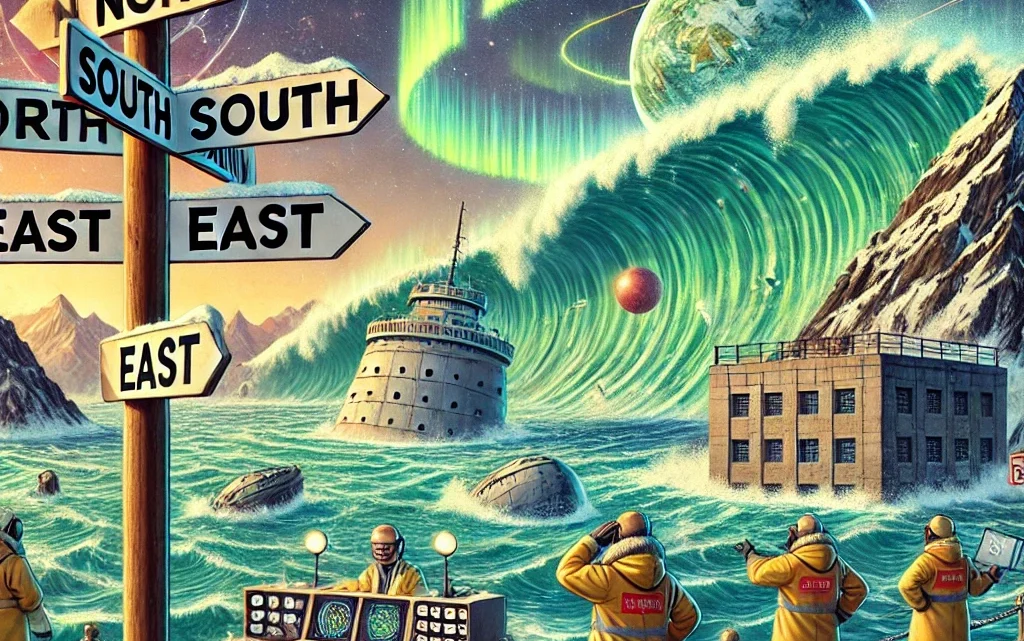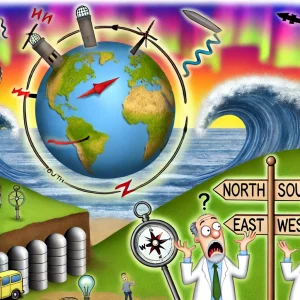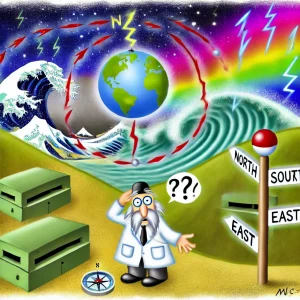The Great Flip: Don’t Worry, Be Happy… But Just in Case

You’ve probably heard it before: “The world is going to end tomorrow!” Or next week. Or maybe even this year. Yeah, we’ve heard it all. But what if, just what if, the Earth decided to play a little game of “swirl-a-roo” with its magnetic poles? Before you hit the panic button, let’s take a look at what’s really going on. And trust me, it’s as wild as it sounds, but maybe not apocalyptic—probably.
A Bit of Science… With a Side of Humor
So, here’s the deal: according to recent studies (because, of course, there are always recent studies), the magnetic North and South Poles are like that one couple that keeps drifting apart. The North Pole is wandering off at a rate of 25-30 kilometers (15.5-18.6 miles) per year, while the South Pole is trying to one-up it by moving 35-45 kilometers (21.7-27.9 miles) per year. It’s almost as if they’re in a race to see who can drift the farthest first.

But don’t panic yet! Scientists, being the cool-headed folks they are, are keeping a close eye on this. They’re saying that a geomagnetic reversal (fancy term for the magnetic poles flipping) is unlikely in the near future… but not impossible. And really, what could possibly go wrong if the Earth decided to switch up its magnetic field?
The Effects of a Geomagnetic Reversal: Welcome to the Apocalypse, Maybe?
So, you might be thinking: “What happens if the Earth’s magnetic field does flip?” Well, let me tell you, it’s not just about the poles switching places like a bad game of musical chairs. No, no. We’re talking massive earthquakes, volcanic eruptions, and maybe even some tidal waves big enough to make you rethink that beachfront property you’ve always wanted.
Imagine waking up one morning and realizing that the Earth’s crust has broken loose from its inner part. That’s right, massive earthquakes and volcanic eruptions could be the Earth’s way of saying, “Hey, humans! Get ready for a wild ride!”
And let’s not forget about the tidal waves—oh, the tidal waves! Picture this: waves as high as 100 feet (30 meters) crashing over the continents. Think of it as the Earth’s ultimate power-washing session. Clean slate, right?
But wait! There’s more! A geomagnetic reversal could also mess with the Earth’s rotation, making the planet tilt on its axis. So, don’t be surprised if one day you wake up and feel like you’re facing the wrong direction. Is it north? Is it south? Who knows anymore?

Preparing for the Great Flip: Because Being Prepared is Better than Not
Now that you’ve had a good laugh (and maybe a nervous chuckle), let’s get serious. While the chances of a geomagnetic reversal happening tomorrow are slim, it doesn’t hurt to be prepared. After all, who doesn’t like being ready for the next potential apocalypse?
Safest Places to Live (Or, Where NOT to Build Your Bunker)
- The Great Plains of North America: Stable, far from major tectonic plates, and less prone to earthquakes. Sounds like a good deal, right?
- Interior Regions of Australia: Also stable, and hey, it’s Australia. You might even spot a kangaroo or two.
- Hills or Mountains with Stable Geology: The Rocky Mountains or the Appalachian Mountains might be your best bet. Plus, they’ve got great views!
Best Structures to Hunker Down In
- Disaster-Resistant Buildings: Reinforced foundations and robust materials are key here. Think of it as your own fortress against the apocalypse.
- Backup Power Systems: Solar panels, wind turbines, and battery storage will be your new best friends. After all, who wants to be stuck in the dark when the power grid fails?
- Higher Ground: Building your home at least 10-15 meters (30-45 feet) above the surrounding terrain could keep you safe from those pesky tidal waves.
Ideal Elevation: Because Higher is Better
- 100-150 Meters (300-450 Feet) Above Sea Level: This should reduce your risk of flooding and storm surges. Plus, you’ll have a great view of the world ending below.
- 200-250 Meters (600-800 Feet) for Extra Safety: If you’re really playing it safe, aim for this elevation range.
Strategies for Mitigating the Effects: What Governments and Organizations Should Be Doing
While you’re stocking up on supplies and building your bunker, governments and organizations should be preparing too:
- Backup Power Systems: Renewable energy sources are a must. After all, the sun doesn’t need a power grid to shine.
- Emergency Response Plans: When the world goes haywire, it’s best to have a plan.
- Climate Adaptation Infrastructure: Rising sea levels? Changing weather patterns? No problem—if we’re prepared.
Conclusion: Don’t Worry… But Maybe Keep an Eye on the News
Look, a geomagnetic reversal probably won’t happen anytime soon, but if it does, at least you’ll be ready with your bunker, backup power, and strategic high ground. So go ahead, breathe a sigh of relief… or don’t. After all, it could happen almost any day now!
References:
- NASA: “The Magnetic North Pole”
- NOAA: “Geomagnetic Reversals”
- British Geological Survey: “Magnetic Pole Shift”
And for those of you who like to live on the edge, check out:
- BBC: “Earth’s Magnetic Field May Be About to Flip: What Would Happen If It Did?”
- The Independent: “Geomagnetic Reversal Could Cause Massive Earthquakes and Tidal Waves”
- Daily Mail: “Scientists Warn of Impending Earth Catastrophe as Magnetic Pole Approaches Critical Point”
Stay safe, stay prepared, and maybe start brushing up on your mountain survival skills—just in case.

